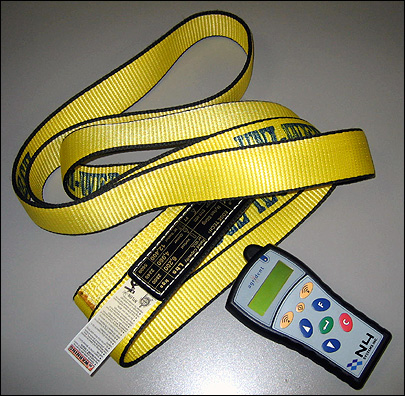Unirope, a Canadian provider of chain and synthetic slings used for the industrial rigging of cargo onto crane hooks and other large machinery, has deployed an RFID-based system called FieldID, for tracking the maintenance and safety inspection records of its products. Unirope inspects and tests its slings to comply with safety standards set by the Canadian Center for Occupational Health and Safety, whose guidelines closely match those set by the American Society of Mechanical Engineers and enforced by the U.S. Occupational Health and Safety Administration (OHSA). The slings must be tested annually.
Unirope partnered with Toronto-based systems integrator N4 Systems to design and implement the RFID tracking system, which uses passive, low-frequency (134 kHz) technology compliant with the ISO 11784 tag data standard and the ISO 11785 air-interface protocol.
Unirope offers its customers safety testing as a service. Some customers, explains Unirope president Knut Buschman, have in-house safety inspectors certified to perform the safety inspections. Those that do not can contract Unirope to perform the tests at the customers’ job sites, or can send the slings to Unirope’s facilities for testing. Unirope also tests its inventory of slings at its Mississauga, Ontario, headquarters.
Before employing RFID, Unirope safety inspectors employed a manual, paper-based system for recording inspection details, using hand-written forms to provide customers with inspection certificates. This process was prone to error, and inspectors sometimes maintained incomplete records. Now, the inspection and maintenance record for each sling is stored electronically in a Web-based database. To identify each sling, inspectors previously read a serialized number from either a stamped metal ID plate attached to the coupling link of a steel chain sling, or a branded leather label sewn to the nylon webbing of a synthetic sling. After extended use of the slings, however, these numbers become very difficult (if not impossible) to read, because of wear and tear to the labels and plates. Now, inspectors use a handheld interrogator to identify each sling, and to call up the sling’s maintenance and inspection history.
Buschman says Unirope is first deploying FieldID across its own operation, and will then work with N4 to provide it as a product for customers that do their own safety inspections. This should eventually enable customers to keep cradle-to-grave records for the slings. “We have a hard time tracing the slings [sent in by customers for inspection],” he says. “We have databases with serial numbers, but the customers don’t always keep good records.”
Unirope could have used a bar code to identify each sling, as this would have improved the accuracy of its records by ensuring the ID numbers were correctly documented. The bar code, however, like the human-readable numbers on the slings, would likely become unreadable in time due to dirt or wear and tear. With RFID, dirt or prolonged usage would not cause such deterioration in performance. Still, Unirope needed tags that could withstand the extreme temperatures and vibrations to which the slings are exposed during their lifetime of use.
Shaun Ricci, co-CEO of N4 Systems, says his company worked with RFID hardware provider R. Moroz to find the best tags and readers for the job. N4, he says, tested a number of low-frequency tags before finding one that performed best. High and ultrahigh frequencies could not be used for this application since metal surfaces interfere with both, but low-frequency RF signals are not affected by metals. In addition, LF’s very short read range (a matter of centimeters) is also not a problem for Unirope, because the slings need not be read from a great distance.Ricci declines to disclose the tag’s providers but says the tags attached to the chain sling can be read from a distance of less than an inch, while those on the synthetic fabric slings can be read from about 4 inches. One of Unirope’s main requirements for the RFID system was that the tags be tightly integrated into the slings so they would not impact the profile or function of the devices.
The tags used to identify the fabric slings are embedded in molded plastic and placed behind the leather label sewn onto each sling. The metal ID plate attached to each chain sling is composed of two thin aluminum sheets, sandwiched together. Unirope and N4 devised a system for separating the two pieces, machining out a small indentation in one plate, then inserting a glass-encased tag and reattaching the sandwiched sheets onto the sling.

To read and encode the tags, N4 provides a Workabout Pro handheld computer manufactured by Psion Teklogix. An Agrident AIR200 low-frequency ISO 11784/5 reader is attached to the handheld via a serial port.
N4 developed a software platform called FieldID for the Unirope application. In the future, Ricci says, the firm plans to work with other companies requiring a system for tracking maintenance or safety inspections, both for industrial and non-industrial goods.
When a sling is first tagged, whether a new sling or one used in the field, the tag ID is accessed to create an electronic file for that sling in the main FieldID database. At that time, a safety inspection is also performed. The inspector keys the results of the inspection tests, comprised of a series of stress and weight tests, into the sling’s electronic file, along with the date and time. The next time that sling comes up for inspection, the inspector will read its tag to call up the electronic record, then perform the inspections and save the results in the record, along with the date and time. The FieldID software can send commands to a nearby printer to make paper copies of the inspection report and, if the sling passed inspection, issue a certificate.
Ricci says one thing that makes FieldID attractive is that since they are Web-based, the sling inspection records are easy to call up from any Web-enabled computer. Moreover, he adds, it’s a hosted application, so Unirope does not need to worry about troubleshooting or maintaining the database.
Thus far, Unirope has tagged and generated FieldID records for 70 percent of its chain and synthetic slings. The remainder is currently in service, says Buschman, and will be tagged as they are returned to Unirope. Once Unirope has completely deployed FieldID, the firm will begin offering it to customers that do their own testing.


